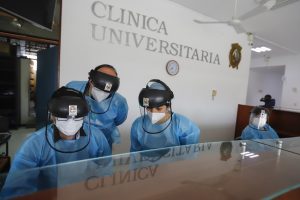Recently, much global media attention has focused on the vaccines produced by the U.S. pharmaceutical firms Pfizer and Moderna, along with specific information on their efficacy: two dosages three weeks apart, with a success rate of 92 percent and 94.1 percent, respectively. Coming on the heels of these announcements, five Chinese vaccines have also been trialed and tested on patients in the UAE, Indonesia, Bolivia, Peru, Brazil, and other countries.
Less has been said about the important role of the German biotechnology firm BioNTech, which collaborated with Pfizer and whose team played a crucial role in discovering the first COVID-19 vaccine. At the center of the was a couple, Germans of Turkish descent, who were the first to employ successfully the so-called MRNA method to stop the menace of SARS-CoV-2.
MRNA has been known to the scientific world since 1990. It is a mechanism that “teaches” cells how to memorize the process of building themselves into proteins. To prevent infections from happening at all, vaccines based on the MRNA method enhance the creation of antibodies that will protect the immune system from being overwhelmed by COVID-19, a coronavirus that is sheltered by a layer of “deceptive” protein.
Firms in China, for all their claims to have produced five vaccines, has not taken the MRNA approach, preferring a more traditional method. Yet, just as its vaccines began being rolled out to front-line health workers and other priority individuals, the Chinese government failed to declare that its companies’ vaccines had only passed phase 2 clinical trials, not the all-important phase 3.
Meanwhile, tens of thousands of people have been tested abroad as part of phase 3 trials, with widely divergent evidence as to their efficacy. Indeed, the South China Morning Post reported this month that according to Brazilian researchers, one of the five vaccines, produced by Sinovac Biotech, had a relatively low effectiveness of 50.4 percent, after previously declaring the efficacy rate to be 78 percent. In this context, China’s response to vaccine development appears as opaque as when COVID-19 first exploded in Wuhan (although there are scientific studies that showed that Italian lung cancer patients had had mild exposure to SARS-CoV-2 in October 2019, only that their doctors could not detect them since the virus was so new and less infectious then.)
Given that the first COVID-19 vaccine was administered to a 90-year-old woman in the United Kingdom on December 17, it is clear that European researchers have been in lockstep with their counterparts in the U.S., as their inoculation programs both started in December. Indeed, in May 2020, Professor Sarah Gilbert of the University of Oxford, working in tandem with the London-based pharmaceutical firm AstraZeneca, had tested a beta version of the vaccine on herself and her triplets. This vaccine and others are now being manufactured and dispatched across the world.
No one knows if China’s vaccines can indeed be made a “global public good,” as President Xi Jinping declared they would be in April. As Ardhitya Eduard Yeremia and Klaus Heinrich Raditio argued recently in the Japan Times, “China seeks to dominate the Indo-Pacific region, and now the success of its vaccines is a crucial aspect for its influential power.” Yet the development of COVID-19 vaccines, from the laboratory to mass vaccinations, requires six stages, and China has so far only shown it can keep up with European and Western vaccines up to the third stage, which is clinical development.
Many Southeast Asian nations have turned to China in their bid to secure access to a COVID-19 vaccine. Hence, the media has spun a tale of a Health Silk Road, in which China makes strategic inroads in developing countries by offering access to life-saving inoculations. But like other nations, China is racing against time. All vaccines have short shelf lives of two weeks to a month, and the receiving countries must have the necessary cold chain technology to preserve them, either at minus 2-8 Celsius or minus 70-80 Celsius. At this stage, the five vaccines produced by China claim to be able to retain their efficacy at the former temperature, facilitating their distribution in developing countries.
Yet there remains a lingering question about the effectiveness of the Chinese vaccines. This is partly because of the difficulty in being able to verify the widely divergent efficacy rates that have been released, and because the results came after Pfizer, BioNTech, and Moderna had released their findings.
To date, no African countries have received Chinese-made vaccines, aside from the Seychelles, which has received 50,000 doses. Perhaps China can ultimately make good on its promise to the whole world, but to claim that China is winning at “vaccine diplomacy,” as two authors did recently in Foreign Affairs, is premature. It underestimates the scientific capacity of Europe and the U.S., and their ability, either singly or combined, to equal China or even to race ahead in terms of vaccine efficacy. While one Chinese scientist claimed that the MRNA approach of the American and European vaccines was too risky, the same scientist did not mentioned if tests were conducted in China to challenge the validity of the MRNA approach.
Kim Beng Phar is founder/CEO of Strategic Pan Indo-Pacific Arena.
Clementine Bizot is senior research fellow at Strategic Pan Indo-Pacific Arena.

































